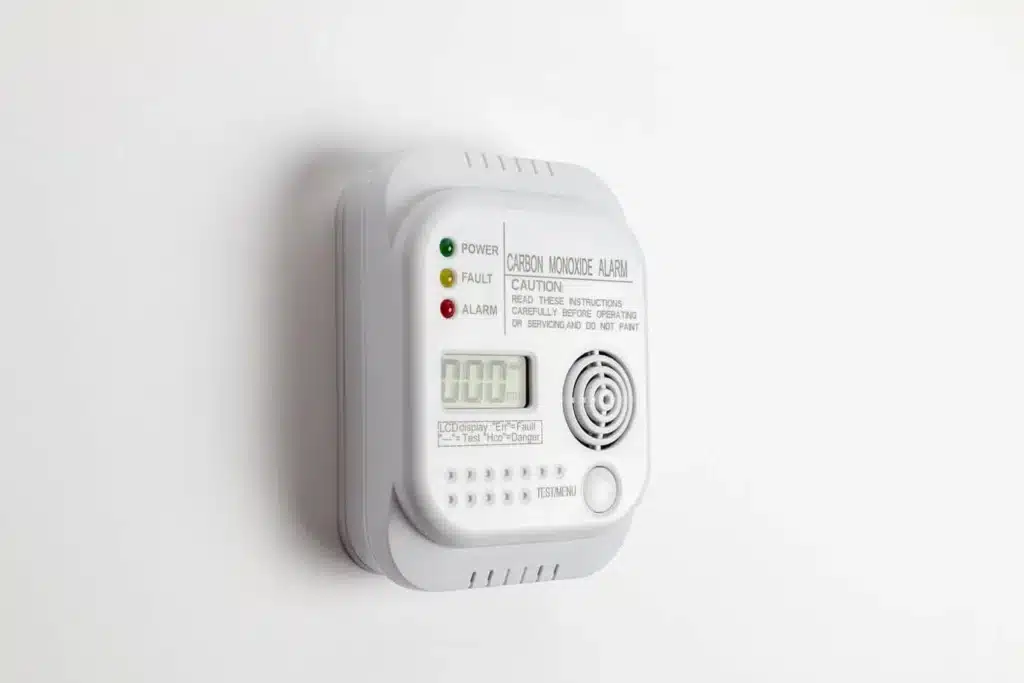As a homeowner, keeping your family safe and your investment protected are key components of home ownership. This can occur in many ways. Most homeowners are very aware of installing a security system or making sure the batteries work in their smoke detectors. However, many homeowners never even consider a carbon monoxide detector. It would be a great idea to install a carbon monoxide detector if you use gas to fuel any household appliances. Can a gas fireplace cause carbon monoxide? Anything that burns natural gas, propane, or oils as a fuel source will release carbon monoxide.
Let’s take a look below at some more details regarding carbon monoxide.
What Is Carbon Monoxide
Carbon monoxide is known as a silent killer. This is due to it being colorless, tasteless, and odorless. It is a gas that is a by-product of burning fossil fuels. You can create carbon monoxide in any item that burns gas. Running your car, gas-powered appliances, and a gas-powered fireplace are all examples of items that create carbon monoxide. If there is a break in the exhaust vent or damaged parts in the fireplace, carbon monoxide could escape into the home. This would be life-threatening to you and anyone else in the home.
Why Does It Occur
When it comes to carbon monoxide, there are a few ways that it can enter your home. Let’s take a look at the more common ways for carbon monoxide to get into your home.
- Gas fireplace – a gas fireplace, wood stove, or wood-burning fireplace could all create carbon monoxide. If any of their parts are damaged or malfunctioning, the gas could escape into your home.
- Car – running your car while in the garage is a bad idea. The gas from the burning fuel will stay in the air and can get into your home.
- Appliances – any appliance that is using gas as a fuel can produce carbon monoxide. This means your water heater, stove, or even clothes dryer.
- Grill – when charcoal is burned it releases carbon monoxide. So, if you are grilling too close to the home, you risk the possibility of carbon monoxide gas entering the home.
The bottom line is that you ensure that any gas-fueled item in your home is ventilated.
What Are The Symptoms Of Carbon Monoxide Poisoning
Considering that carbon monoxide is odorless, tasteless, and colorless, it is impossible to detect. However, when carbon monoxide is released into the air, it can be inhaled and cause some major reactions in your body. The most common symptoms associated with carbon monoxide poisoning are as follows:
- Headache
- Shortness of Breath
- Chest Pain
- Dizziness
- Nausea
- Passing out or unconsciousness
If any of these symptoms occur and are not related to having a cold or flu, you should immediately call 911. Explain to the emergency medical responders your symptoms and ask them to check for a gas leak.

How Can I Prevent It
Believe it or not, there are a few ways that you can prevent carbon monoxide from entering your home. Let’s take a look below.
- Chimney and fireplace maintenance – proper maintenance of your fireplace and chimney will ensure that the ventilation of gases is secure.
- Ventilation – if you are using gas-fueled appliances and a gas-fueled fireplace make sure that they are properly ventilated. You won’t be opening your windows in the winter months, so the gas must have somewhere to go.
- Carbon Monoxide Alarm Detector – there are a variety of carbon monoxide alarm detectors available for purchase. No matter which type you choose, make sure that it is tested and works properly. You can utilize an electrical outlet or have the system hardwired into your home’s alarm system. These systems can alert you to danger and if needed, notify emergency services.
Other Recommended Maintenance
Now that you are aware that your gas-fueled fireplace can produce carbon monoxide, it is a great idea to read up on how to tell if the gas is present. The more you can read up on carbon monoxide and understand how to check for it, the safer you and your family will be.
Another great way to ensure that carbon monoxide is not entering the home is by installing fresh air intake vents. Every gas appliance that you are using should have a fresh air intake vent. If you aren’t sure what they are, read up. The more you understand what fresh air intake vents can do, the safer your house becomes.
Lastly, double-check your water heater. It is possible that a gas line has been installed to power your water heater. If you start to notice that it is taking longer to heat your water, this could be an issue. Keep in mind that factors such as distance from the faucet to the water heater can determine how long it takes to deliver hot water.

When Do I Call A Professional
Making sure that your family is safe is your top priority. If you purchase a home that has a gas line and uses gas as a fuel source, you will want to install a carbon monoxide detection system. Hiring a professional to ensure that this system is functioning properly is very important. Also, consider reaching out to your local home inspection team. They can inspect the gas line and the appliances that use the gas. Additionally, they can recommend a reputable fire and safety carbon monoxide installation company.
Conclusion
Protecting your family from the threat of carbon monoxide is paramount. Taking the proper precautions should be easy to do. Installing a carbon monoxide detection system is also easy to do. Regardless, conducting the proper maintenance on your gas-fueled fireplace can ensure that carbon monoxide does not enter the home. Also, you will be able to enjoy the use of your fireplace and not be so concerned about safety issues. Reach out to Enviroquest Home Inspections for carbon monoxide, gas fireplace, and complete home inspections in Harrisburg, PA.
